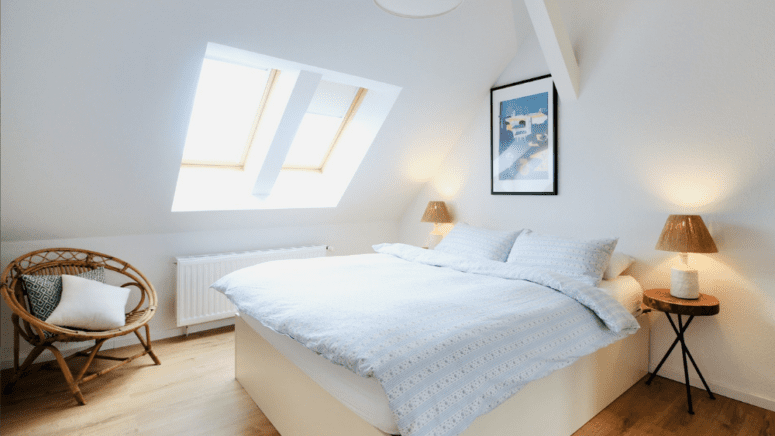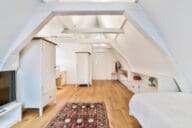How to Add a Room to a House Cheap (5 Affordable Strategies)
- Published on
- 9 min read
-
 Richard Haddad Executive EditorClose
Richard Haddad Executive EditorClose Richard Haddad Executive Editor
Richard Haddad Executive EditorRichard Haddad is the executive editor of HomeLight.com. He works with an experienced content team that oversees the company’s blog featuring in-depth articles about the home buying and selling process, homeownership news, home care and design tips, and related real estate trends. Previously, he served as an editor and content producer for World Company, Gannett, and Western News & Info, where he also served as news director and director of internet operations.
Expanding your living space can breathe new life into your home, but the cost of adding a room might seem daunting. Fortunately, there are affordable strategies to achieve this without breaking the bank. Whether you’re looking to enhance functionality or increase your home’s value, this guide will share how to add a room to a house cheap.
We’ll also provide a variety of room addition ideas and present cost estimates for everything from converting an attic to creating an in-law suite.
Most common room additions
When considering an addition to their home, homeowners typically think about expanding or creating spaces that enhance their living experience. Here are some of the most common room additions:
- Bedroom: Adding an extra bedroom can accommodate growing families or provide a guest room for visitors.
- Home office: With more people working from home, a dedicated office space is a highly sought-after addition.
- Laundry room: Moving the laundry room to a more convenient or larger space can improve functionality.
- Mudroom: A mudroom offers a transitional space where outdoor clothing and shoes can be stored, keeping the rest of the home clean.
- Expanded kitchen: A larger kitchen can improve meal preparation and entertaining spaces.
- Bathroom: Adding a bathroom can ease household congestion and improve privacy.
- Sunroom (four-season room): A sunroom adds a bright, versatile space to enjoy year-round, regardless of the weather.
- Garage conversion: Turning a garage into a living space can provide a large, versatile area without the need for a traditional addition.
The garage conversion resale value debate
If you’re considering converting your garage into livable space, such as an extra bedroom, man cave, or recreation room, the ROI is debated. On one hand, if the conversion is done well, Angi.com reports you may achieve up to an 80% ROI. On the other hand, many real estate agents warn against this addition because you are removing a feature that future buyers may want. If you live in an area where parking space is scarce, such as an urban neighborhood, your garage conversion can actually decrease your home’s value.
Later in this post, we’ll also list some less-common room additions and show estimated costs for each option, helping you make the best decision for your home and budget.
5 ways to add a room to a house cheap

1. Build a bump-out addition
Bump-out additions are a cost-effective way to add a small amount of space to a room, such as adding an office, creating a dining room area, expanding a kitchen, or putting in a bathroom. Since they don’t require HVAC systems or a new foundation, and often use existing walls, bump-outs are significantly cheaper than full additions.

2. Finish a basement or attic
Finishing existing space within your home, like the basement or attic, can be a budget-friendly way to add a room and additional home value. This option can transform unused areas into livable spaces, such as a home office, bedroom, or entertainment area, without altering the footprint of your home. In most cases, necessary HVAC and water systems are already in place.

3. Create a FROG (finished room over garage)
Finishing the space above your garage to create a FROG can add valuable living space without the costs associated with traditional additions. This area is ideal for a guest suite, home office, or playroom. FROGS are often a coveted feature and a selling point for homebuyers.

4. Add a sunroom
Because the walls are typically entirely made of windows or sliding glass doors, Sunrooms are a less expensive way to add space and light to your home. Opting for a simple, prefabricated sunroom can keep costs down while providing a beautiful area to relax and entertain. These rooms often add year-round brightness and joy to a house. However, the ROI on a sunroom is only estimated to be about half of the money invested because unless it’s heated and cooled by the same HVAC system in the rest of the house, it cannot be counted as additional (livable space) square footage.

5. Consider a smaller addition
Small-scale additions, such as a dormer or cantilever, can add space where it’s needed most, like creating a larger bathroom, extending a bedroom, or adding a walk-in closet. These types of additions are less invasive and more affordable than full-size room additions. Dormer and cantilever additions can also add extra light to darker areas of your home.
How much does a room addition cost?
Adding a room to your house can vary widely in cost, depending on the type of room, materials, and labor. Here are some estimated costs from HomeAdvisor for various room additions:
- Converting an attic: $40,000
- Full bathroom: $35,000
- Primary bedroom: $62,500
- Primary bedroom suite with bathroom: $100,000
- Dining room: $20,000 to $45,000 (14×16 feet)
- Kitchen addition: $20,000 to $90,000
- Laundry room addition: $8,070
- Living/family room: $20,000 to $45,000 (12×18 feet)
- Mudroom: $12,000 (50 square feet)
- Simple sunroom: $8,000 to $11,000
- Large, wired sunroom: $80,000 (200 square feet)
- Bump-out room: $5,000 to $10,000
- Cantilever: $15,000 to $25,000 (upper-floor unsupported horizontal extension)
- Dormer: $5,000 to $10,000 (extended window opening in a loft or attic)
- Garage conversion to room: $6,012 to $26,989 (resale pros and cons)
- Garage addition: $25,000 to $50,000
- In-law suite: $50,000 to over $100,000 (studio or apartment)
- Prefabricated modular room: $20,000 to $30,000, (prebuilt units)
Other room addition options
Exploring alternative ways to create more living space can often provide creative and cost-effective solutions. Here are some options to consider:
Add a loft above a room with a high ceiling
Taking advantage of vertical space in rooms with high ceilings can add an entirely new dimension to your home. A loft can serve as an extra bedroom, a cozy reading nook, or a unique home office.
Divide a room into two rooms
If you have a large room that feels underutilized, consider dividing it into two distinct spaces. This can be an efficient way to create an additional bedroom, a home office, or a multi-purpose room without altering the exterior of your home.
Repurpose a rarely-used room
Reimagining the use of spaces within your home can unlock new value without the need for construction. Transforming a seldom-used dining room, for instance, into a home office or a playroom can meet changing needs without a significant investment.
Building up rather than out
If your lot size limits horizontal expansion, consider adding a second story or expanding your attic. Building up can significantly increase your living space and can sometimes be more cost-effective than a ground-level addition, especially in areas where land is at a premium.
These alternatives can not only add valuable space to your home but also potentially increase its value and functionality, offering creative solutions to your spatial needs.
Does adding a room to a house add value?
Adding a room to your house can indeed increase its value, making it a good investment in many cases. However, the added value varies depending on the type of addition and the current market trends in your area. According to HomeAdvisor, here are a few return-on-investment (ROI) estimates for different types of room additions:
- Adding a bathroom: 53%
- Adding a primary bedroom with bathroom: 63%
- Adding a sunroom: 49%
- Making a two-story addition: 65%
These figures suggest that while most additions will increase your home’s value, the extent of the increase depends on what you add and how it complements the existing structure and design of your home. Most additions, when done well, can add value on several levels — both in enjoyment while you live there, and in marketing appeal and additional proceeds when you sell the home.
Risks of a DIY room addition
Undertaking a room addition as a DIY project can be tempting, especially with the potential savings in labor costs. However, there are a few risks involved:
- Quality and safety: Without the proper skills, tools, and permits, you might compromise the addition’s quality and safety, making it a liability rather than an asset.
- Ad lib additions: When is comes to room additions, winging it can prove costly. If you go the DIY route, have a solid plan, so you avoid damaging what is likely your most valuable investment.
- Resale appeal: Poorly executed additions can detract from your home’s overall appeal, potentially hurting its value and making it harder to sell in the future.
- Cost overruns: DIY projects can often exceed budget due to unexpected issues, underestimating materials, or the need to redo work.
- House harmony: When adding a room, think about how it will fit the rest of the house. The design should be congruent with the floor plan and style of your existing home. An addition should match the structure and even the vibe of other homes in the neighborhood. It should not stick out like a sore thumb.
Before deciding on a DIY approach, carefully consider your skills, the project’s complexity, and the potential impact on your home’s value.
5 questions to ask before you add a room
Before diving into the planning and execution of a room addition, it’s important for homeowners to assess their readiness and objectives for the project. Here are five essential questions to consider:
- What is my primary goal for the addition?
Reflect on what you aim to achieve with the new space, whether it’s accommodating a growing family, enhancing the property’s value, or adding a specific room to improve your lifestyle.
- How will the addition affect the overall flow and aesthetics of my home?
Consider how the new space will integrate with the existing structure. Will it complement your home’s current layout and design, or could it potentially disrupt the flow and aesthetics?
- Am I prepared for the potential disruption to my daily life?
Construction projects can be invasive and lengthy. Assess whether you and your family are ready to handle the noise, dust, and possible inconvenience that come with home renovation.
- Do I have a realistic budget set aside for this project?
Beyond just the cost of construction, have you accounted for potential overruns, additional features, or unexpected expenses? Ensure you have a financial cushion to cover the complete scope of the project.
- Have I researched and planned for the necessary permits and regulations?
Every locality has its set of building codes and permit requirements. Are you familiar with these, and have you factored in the time and cost to comply with local regulations?
These questions can help homeowners gauge not only their readiness but also the feasibility and scope of their intended room addition, ensuring a smoother process from start to finish.
Bottom line: There are ways to add a room to a house cheap
Adding a room to your house can be a strategic way to enhance your living space and increase your home’s value, provided it’s done thoughtfully and efficiently. Whether you opt for a cost-effective bump-out, convert existing space, or embark on a larger addition, understanding the costs, potential returns, and risks involved will help you make informed decisions.
If you’re curious about your home’s current value, HomeLight’s Home Value Estimator tool can give you a ballpark value so you can plan your project with a clearer understanding of its impact on your investment.
Header Image Source: (Beazy / Unsplash)
- "15 Tips On Garage Conversion Into A Living Space," Forbes, Lee Wallender & Samantha Allen (May 2023)
- "6 Tips for Turning Your Garage Into a Livable Space," Angi, Lauren Murphy (November 2021)
- "House Bump Out Ideas On a Budget," Contractors.com, Alex Mikayelyan (February 2024)
- "Should You Add A Sunroom To Your House?," Forbes, Nick Gerhardt & Samantha Allen (May 2023)


